「ねえ、お花見に行かない?」
= Nee ohanami ni ikanai?
= Hey, do you want to go see the cherry blossoms?
「お団子はあるの?」
= Odango wa aru no?
= Are there “odango” (= sweet dumpling)
Hi, everyone!
After a long cold winter, I finally feel the hint of spring in the air.
Spring in Japanese is
![]() 春 = haru
春 = haru
春はもうそこまで来ています。
= Haru wa mou soko made kite imasu.
= Spring is just around the corner.
It’s my favorite season.
If you are planning to come to Japan, it would be nice to visit in the spring. It’s a great chance to see our beautiful cherry blossoms.
Today’s guest teacher is Basil Farrow. Remember him in ググるLesson? And this lesson is for his mom, La Carmina, the coolest Japan Goth blogger/TV reporter/author/journalist around. She will be hosting a Belgian TV documentary in Tokyo about what else? Cherry blossom season!
(Go check her website La Carmina It is REALLY cool!!)
So this lesson is about 桜 = sakura = cherry blossoms!
OK, here we go!
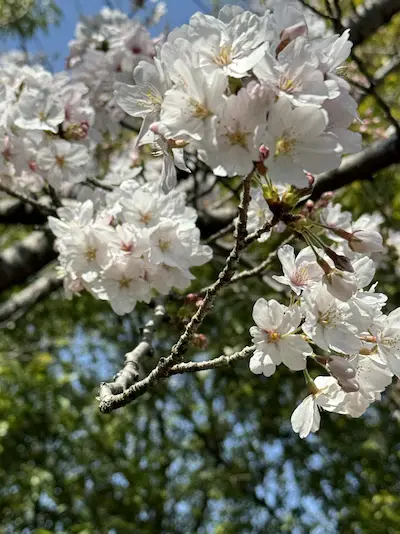
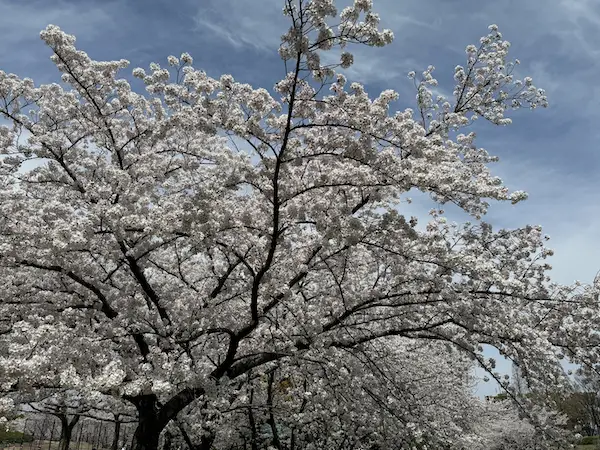
First of all, the above-mentioned cherry blossoms are known, in Japanese as:
![]() 桜 = さくら = sakura
桜 = さくら = sakura
In Japanese flower(s) is 花 = hana
So cherry blossoms flowers are called
![]() 桜の花 = sakura no hana
桜の花 = sakura no hana
Other related words:
•桜の花が咲く= sakura no hana ga saku = cherry blossoms bloom
•桜の![]() 花が散る = sakura no hana ga chiru = cherry blossoms fall
花が散る = sakura no hana ga chiru = cherry blossoms fall
or 桜の花びらが散る = sakura no hanabira ga chiru = the petals of cherry blossoms flutter down
Note :
•In the old days, we sent telegrams to announce whether or not someone had passed their exams or not. If they pass them, the telegrams say サクラサク= sakura saku = He/she passed the exam and if they fail, it says サクラチル= sakura chiru
• A fake customer or decoy, by the way, is called サクラ = sakura.
Ex. 私がサクラになって来てあげようか。
= Watashi ga sakura ni natte kite ageyou ka?
= You want me to be a fake customer (for you and help you) to get real customers?
↓
•花吹雪 = hana fubuki =shower of blossom
(The literal meaning of 吹雪( = fubiki) is snow shower)
They start to bloom in late March and last through the beginning of April.
Sadly, they only last for about a week.
When the cherry blossoms start to bloom we say,
•桜の花が咲き始める= sakura no hana ga saki hajimeru
A more formal way to say the same thing,
•桜の花が開花する= sakura no hana ga kaika suru
= Cherry blossoms come into bloom
Every spring, we hear the following on the weather report,
Ex. 東京で桜の開花宣言
= Tokyo de no sakura no kaika sengen
= The official declaration of blooming cherry blossoms in Tokyo
•桜の開花予想
= sakura no kaika yosou
= estimation for blooming of cherry blossoms
•桜の開花状況
= sakura no kaika joukyou
= the blooming cherry blossom report
There are many kinds of cherry blossoms (over 200 kinds!!) but when they talk about this forecast, they are based on cherry blossoms called ソメイヨシノ = somei yoshino.
The line connecting all the 桜の開花予想日 ( = sakura no kaika yosoubi) of Japan is called 桜前線 = sakura zensen = cherry blossoms front
Every year, we hear on the weather report saying
Ex.桜前線が北上しています。
= Sakura zensen ga hokujou shiteimasu.
= The cherry blossom front is moving north.
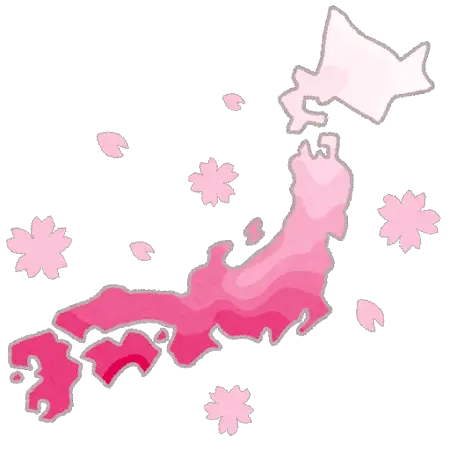
(Note: Since Japan is a long island, cherry blossoms first start to bloom in the south = 南= minami )
We describe the way they bloom as follows,
•五分咲き = gobuzaki = to bloom about 50 pct
↓
•七部咲き= hichibu zaki = to bloom about 70 pct
:u:
•八部咲き = hachibu zaki = to bloom about 80 pc
↓
•満開 = mankai = full bloom (八分咲き = hachibuzaki is considered to be 満開 = mankai = full bloom)
So the weather forecast announce both
•開花予想日 = kaika yosoubi = estimated date for blooming
and
•満開予想日= mankai yosoubi = estimated date for full bloom
You can enjoy cherry blossoms in many places in Japan.
Temples, parks, river sides, mountains, etc.
but the famous locations where you can see beautiful cherry blossoms are called
![]() •桜の名所 = sakura no meisho
•桜の名所 = sakura no meisho
They are places where you can enjoy cherry blossoms illuminated by the lights at night.
•夜桜= yozakura = cherry blossoms at night
Ex. 夜桜を見に行く = yozakura wo mini iku = to go see cherry blossoms at night
Viewing cherry blossoms is called
![]() •花見 = hanami
•花見 = hanami
or
![]() •お花見 = ohanami (more polite)
•お花見 = ohanami (more polite)
Usually when we say 花 ( = hana) it refers to flowers in general but when we say 花見 ( = hanami) it almost always refers to cherry blossoms (or occasionally 梅の花= ume no hana = Japanese plum)
Verb
↓
•お花見をする = (o) hanami wo suru = to view flowers
•お花見に行く = (o) hanami ni iku = to go see flowers
It is said that this cherry blossom viewing tradition started in the 7th century or perhaps even earlier.
When we say 花見 ( = hanami) cherry blossom viewing 2 types of activities spring to mind.
One type of 花見 ( = hanami) focuses on appreciating the beauty of the cherry blossoms themselves.
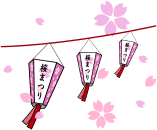 But a lot of time 花見 ( = hanami) is just a wonderful excuse to have a party outside. We eat and drink (and occasionally even sing Karaoke or even dance.
But a lot of time 花見 ( = hanami) is just a wonderful excuse to have a party outside. We eat and drink (and occasionally even sing Karaoke or even dance. ![]() ) beneath the cherry blossom trees.
) beneath the cherry blossom trees.
Many cherry blossoms viewing areas have a lot of 屋台 = yatai = food stands
In addition, people bring their own drinks and food and have little picnics under the trees
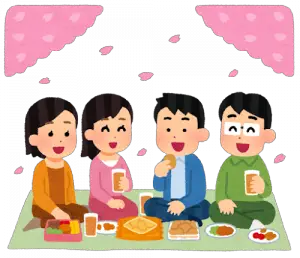
or they have drinking parties under the trees.
![]() 宴会 = enkai = drinking party
宴会 = enkai = drinking party
and have
![]() 花見酒=hahami zake = drinking sake viewing cherry blossoms
花見酒=hahami zake = drinking sake viewing cherry blossoms
Since everybody wants to have a drinking party under the beautiful cheery blossoms tree, it is always hard and hard to get a good spot.
:u:
•場所取り = basho to(do)ri = to keep the place (for 花見 = hanami)
Many companies send their 新入社員 ( = shinnyuushainn) = newcomers as its 幹事 = kanji = party organizer to stake out a good spot. It’s not uncommon for them to go there early in the morning or even the night before the party!
So for many people 花見 ( = hanami) means to eat and drink near the cherry blossoms.
If you haven’t seen the lessons I made regarding drinking or alcohol-related Japanese, you might wan to check those lessons now.
酒 ( = sake) lesson + 酔う( = you= to get drunk) lesson
Although the Japanese have an international reputation for being shy and reserved, you will be surprised to see all the crazy antics that the Japanese people get up to as they drink, sing, and dance under the beautiful flowers.
(I know, I know…. we have a very square image but once we get loosened up… it is out of control!)
For many Japanese, it is more fun to eat and drink than to enjoy the flowers.
It is called
!to right! 花より団子 = hanayori dango = dumpling rather than flowers
⭐️ From the picture above:
「ねえ、お花見に行かない?」
= Nee, ohanami ni ikanai?
= Hey, do you want to go see the cherry blossoms?
「お団子はあるの?」
= Odango wa aru no?
= Are there “odango” (= sweet dumpling) ?
団子 = dango = dumpling called 花見団子 = hanami dango 🍡
A typical hanami dango has three different colored dumplings on a stick.
They are made of sweet sticky rice.
(Each color represents a season. White = snow → winter, pink = cherry blossoms → spring, and green = plants and trees → summer)
We also eat
桜餅 (= sakuramochi) in spring
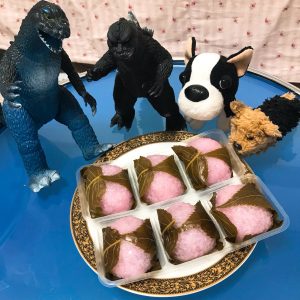
The outside leaf is a real salted cherry blossom leaf and you eat it, too.
You will also see a lot of other sakura-related food or items in Japan in April.
•桜ごはん = sakura gohan = light pink rice cooked with salted cherry blossom,
•桜ワイン= sakura waine = cherry blossoms wine,
•桜茶 = sakuracha =cherry blossoms tea
(Note: This tea is considered to be good luck and we serve it at engagement gatherings, etc.)
We also have tea cups, plates, table mats with cherry blossom designs, etc.
For many Japanese people 桜 = sakura = cherry blossoms are very special flowers.
Some think that it is because 桜 = sakura only last for a short period of time. The beauty of the flowers won’t last long and it reminds you how short life is.
But more than anything with the appearance of cherry blossoms, we feel the coming of spring, and they also symbolize a new start of the school year.
Most Japanese schools start in spring. (So if you are born on March 31 and your friend is born on April 1st, you two will end up being one year apart at school.)
Usually 卒業式 = sotsugyoushiki = graduation ceremonies are held in late March and 入学式(=nyuugakushiki = entrance ceremonies are held at the beginning of April.
Many schoolyards have cherry blossoms so that it is customary for new students, especially new first graders (小学校一年生 = shougakkou ichinensei) to have their pictures taken beneath the cherry blossom trees.
The image of sakura is not only associated with new school years but also corresponds with the time new employees start to work at Japanese companies as freshmen or freshwomen.
桜の季節 = sakura no kisetsu = cherry blossom season is a season to meet new people and also say good-bye to students.
Some graduate from the University or high school and start to work in spring.
Not just students but some businessmen also get transferred to new branches every spring.
マギー先生より= Maggie Sensei yori = From Maggie Sensei
あと、数週間で綺麗な桜があらゆる所で見られます。
= Ato suushuukan de kireina sakura ga arayuru tokoro de miraremasu.
= In a few more weeks, you will be able to see beautiful cherry blossoms everywhere.
皆さんも是非、この季節に”お団子”を食べに日本に来て下さいね。 :)
= Minasan mo zehi kono kisetu ni “odango” wo tabe nihon ni kite kudasaine.
= Come to Japan in this season and eat “dumplings”!
***
Will you be my Patron?
I appreciate your support! サポートありがとう!


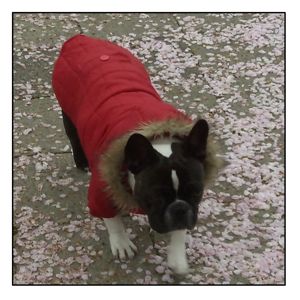
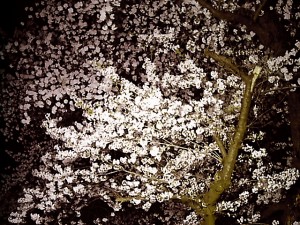





30 Comments
great lesson! thanks!
@VanTilden
Hello!!! Your name looks familiar. Maybe we know each other on FB.
Anyway コメントありがとう!!
Good thing I came across your site, I really love reading your lessons. Keep up the good work sensei! :)
Every time I hear sakura or spring, the song 花は桜君は美しい by いきものがかり comes to mind.
いつかお花見に行きたいです。
@summersky
Thank you for visiting this site! 日本に来るなら桜の季節がおすすめですよ!
haha when I first saw this title it thought it said
花より男女 XD 花より男女がすごいシリーずです。
what it’s called 花より男子 XD
wow now I see why kanji is important >.< The meanings are totally different XD
thanks for the lesson ^w^
@Chalkgoop
ひさしぶり!Thank you for your comment. How is your kitty?
Are you still dancing?
Anyway, 男子 is usually read as “danshi” but it is read as “dango” to make a pun.
Hi Yukari-sensei and Maggie-sensei. :D
I discovered your blog about two months ago and I immediately liked it. I’ve been reading it since then but I was just too shy to leave a comment.
I got worried after hearing the news on the incident last Friday. Even the headlines of the newspaper here in my country (Philippines) are talking about it. This seems to be one of Japan’s most challenging times but I believe you will overcome it. We will always be here to support you through prayers.
BTW, I read your latest post on emergencies but didn’t know where to leave a comment so I decided to write here. Thanks for the great lessons. I always enjoy reading your posts. ^___^
@Amelie
Thank you for your comment and your concern! (Sorry! I just fixed the last post comment section.)
We will keep posting useful Japanese lesson for all of you!
How’s everything after the tsunami and earthquake? 心よりお見舞い申し上げます。Hope 皆さん are OK and life back to normal soon.
@Andini
Thank you for your concern on behalf of all the Japanese people.
マギー先生とゆかりさんは地震で無事でしたか?
マギー先生、日本で地震があったそうでしたが
マギー先生とゆかりは無事ですか?
@ダンさん
心配してくれてありがとう!!二人!?とも大丈夫です!
何より無事でよかったですね~
@ダンさん
世界中のいろいろな方々に心配してもらいました。ダンさんを始め、皆さんの優しさに心から感謝しています。
ありがとう 先生 素敵な文章ですから!
@薫
コメントありがとう!!また来て下さいね。
I know the sakurasakura song!i learned it drg my highschool. I like sakura girl but recently i found another song that i really like which is sakurae by yuzu. Really love that song.
There is 1 traditional song that has seasons in the lyric and family members (haha/ chichi)/tomodachi. I dont really remember the exact lyric but its like “natsu no lalalala hito wa lalala you ni bokuno tomodachi” something like that.
@アリナ
Yuzu’s 桜会 is a nice song,too!!
Hum….I wonder what traditional song you are talking about.
It can be 四季の歌= shiki no uta.
Aaaaahh sou sou. This song!!I remember presenting this song to Japanese students when they came to my school when I was 14. I also hear this song in a drama called Aikurushii.
@アリナ
Good that I found it!! Everybody knows this song ♪
wow you actually answer to everyones’ questions
awesome lesson btw
now Im not going to miss one of them
I wish I can see the Sakura season.
Also, does school end and start in spring in Japan?
@Kurosaki
Hi, Kurosaki!! Thank you for leaving a comment. Yes, as I mentioned in the lesson, schools end and start in spring in Japan.
Hope you come back to this site!
Thank you for these information. Your blog is very interesting to read!! ^~^
Though you should have added Sakura Girl by NEWS (song…) too <3
xx
@Rina
Thank you for the comment!
You like NEWS, huh? Unfortunately I couldn’t find a good PV…
when I first saw “hana yori dango” I thought of that drama :) but no saying goodbyes either in school or at work^^
but no saying goodbyes either in school or at work^^
that’s SOOO different from here! we sre just generally busy as always at this time of the year no special parties or anything to celebrate spring
and the only place that’s got LOTS of cherry blossom trees in the US is (sensei shitteiru kana?)-Washington, DC!! saw them there 3 years ago and loved them^^ the trees were a gift from Japan to US many years ago and they got a festival in DC too! (no sakura kind of food there though)
I don’t like AKB48 much but sensei you know SNSD (Girls’ Generation)? they are from Korea but they sing in Japanese too^^
and yeah I checked out La Carmina’s site after I saw it on here and watched her videos on there^^ she’s so cute and her english is perfect!!
oh and I really like how Japan has something special for every season! autumn-yams and stuff; winter-the beautiful Xmas decorations, fried chicken, love; spring-ohanami, summer-festivals&fireworks
always something going on there! you guys must really like to party :)
@Aki
“花より男子” came from the saying, 花より団子
もちろん!I know 少女時代=SNSD. They are sooo cute!
Good that you checked the La Carmina’s site. She is very cool!!
You are right. We have a lots of seasonal events. What is your favorite season?
少女時代 <3333
mmm haru to aki ^^ spring cause of it's BEAUTIFUL weather (it's warm but not too hot and it's just right ;) and autumn cause it's got pretty colors and I was born in autumn! (september 17^^v) plus, my name sounds like "autumn" in japanese heheh so it matches me well cause of my birthdate :)
I heard that Aki is usually a guys name though… and girl is usually "Akiko" ne?
@Aki
People tend to favor the season when they are born.
There are a lot of girls whose name is Aki
亜紀、亜希 etc. Cute name!!